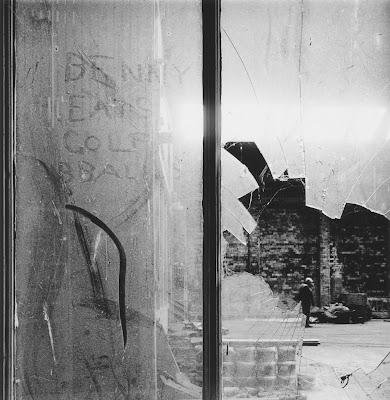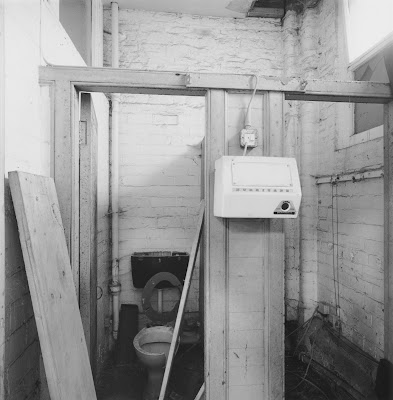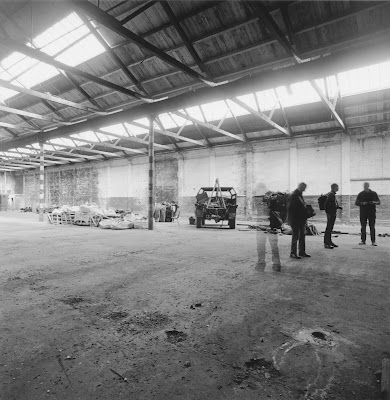Morning folks - I have to admit that I have been quite tearful recently.
And why's that? you might ask, and I'll tell you . . .
Muuuuum!! It was that Bruce from The Online Darkroom. Muuuuummmmm!
 |
| Ilford FP4+ At Work |
But first let me explain myself - I was recently incredibly lucky to be allowed, properly allowed, inside a derelict building.
No mincing about making sure the rozers haven't seen you . . . oh no, someone actually opened the door! The place was Dundee's Maryfield Tram Depot and for nearly all of its life from 1901 to 1956 it was just that - a massive hangar in which to store trams.
When the trams were decommissioned it saw life as a property for corporation buses and then reached an ignominious end in the hands of Scottish Water.
It has been empty/derelict for roughly 20 years and was in a state of potential collapse before it caught the eye of Dundee Transport Museum.
Hopefully, with a TON of cash in the form of funding, and most importantly vision from its board, this wonderful (and large) old building will be brought back to life as just that - a museum that reflects the story of the cities transport systems.
I can't wait.
I have to say I do have an affinity with lovely old places (like the depot) that have been treated really badly.
I dunno, I always feel that there's something of the spirit of the place hanging around in darker corners and eaves and so on, waiting for someone who actually gives a damn to come along and rub their chin and say:
"Well . . . . maybe . . . "
Anyway, a bunch of us from the DCA Photography Forum got a chance to go.
I packed the Hasselblad SW; the Gossen Lunasix-S; a tripod and some FP4 and had a bloody great time.
I got home, eagerly processed the film in Pyrocat-HD and then next day made a contact print and winged a snap of it over to Bruce ('cos we do such things) and awaited his (always) considered, objective and knowledgable opinion . . . . and this is what came winging back and what set me off a-blubbin':
You’re going to hate me, Phil, but I think digital is better suited to photographing the interiors of old buildings than film. There, I’ve said it. I spent a while looking at Neil’s (Neil, being another member of the forum) pictures and your contact sheet and I can’t really see any advantages from film.
Take the “comparison” pics I’ve attached - and I know yours is just a contact so it’s very unfair. But do you see yourself being able to get as much detail and micro contrast out of that scene? That Leica must be some camera as I don’t think I’d have got results like Neil’s from the D700. Neil obviously knows his way around Photoshop or whatever but I think he stays on the tasteful side of editing. The highlights in his comparison pic are spot on I think, loads of detail but light enough that you get the sense of the contrast between the darkness in the building he’s standing in and the adjacent building. Did he use a bit of HDR right enough? If so, he’s done it well. The texture in that scene is amazing. You can see the unevenness on the surface of every brick.
You’re going to have a job getting something like that out of the FP4 because film is HARD compared to digital. In the recent past I might have dismissed the digital shots as, “Well, yeah, that’s the computer doing all the work.” But just concentrating solely on the images and not thinking about the processes, then digital produces better results in most cases. I think that’s what’s changed for me: I’m now more concerned about the print in my hand rather than how it got there. Yes, there’s all the tradition behind film, Minor White, Ralph Gibson, Ansel, etc, but the reality is that these guys used film because it’s all they had and most would have used digital had it been available to them. You’re presumably using MF for sharpness and a lack of grain but digital does that much better. If you use 35mm for grain and a (comparative) lack of sharpness then you’re playing to film’s strength. Basically, digital does MF better than MF but film does 35mm better than digital.
Here's two of Neil's photographs - he was using a Leica M 240 and 21mm Elmarit.
 |
| © Neil Robertson |
 |
| © Neil Robertson |
They're good aren't they, and even rather film-like - especially the second one.
Hmmmm - was The Robbins right?
Two boxes of Man-Size Kleenex and a day later, I was still upset; so much so that I sobbed all the way to the darkroom.
I had to prove something to myself, because I respect Bruce's opinion and his judgements of both image and print making. I also respect Neil's photography - he's been doing it for a very long time and has probably used more cameras than you've had hot dinners! And (amongst other things) he's a really good street photographer too.
Anyway, with gritty determination, I fired up the DeVere 504 with the 100mm Vivitar and made some prints.
It can be unusual making 8 prints from a film that only has 12 frames on it, but I was happy with all of them; in actuality I could probably have printed 11, but stuck at 8 as it gets really hard to dry that many big prints in my tiny darkroom - especially so when you're using a caravan retractable clothes line as your hanging source!
My current image size is 8 x 8" on 9.5 x 12" Ilford MGRC Pearl - that will continue as long as I have that size paper left, after which economics will dictate that I revert to 10 x 8".
The developer I used was some truly ancient Adox MG (it had been in one of those soft pack things for at least a couple of years); they were then double fixed and selenium toned.
I'm really happy with them.
They're different to Neil's photos - he bought some really fine inkjet prints of them along to the last meeting and we compared notes.
As I said before, he'd been using a Leica M 240 with a 21mm Elmarit.
To my eyes they look different, yet in some ways quite similar - especially my sixth one down (compared to his first photograph); his camera picked out details on the wall that were virtually invisible to me (my meter reading for those shadows was EV 1) - such is the nature of modern photography!
Anyway, here's my prints - all scans of the original silver gelatin jobs.
I still think MF is a very valid format - OK it isn't all bells and whistles and hyper-reality, but it does a very good job of conveying space and light and atmosphere (though how you can judge that I have no idea).
As with all these things, it is also the process itself that ensures its validity.
I simply wouldn't bother if I were able to check things immediately and then spend the afternoon dealing with them on a computer; I just love the sheer footeriness and downright challenge that Medium Format photography brings; it's a considered and methodical way of doing things to me, and I will continue to do it for as long as I am able.
The thing I would say about MF is, definitely 'professionally' it's as dead as a dodo - you just have to look at the slew of images in this year's Hasselblad Masters competition to realise that THE name in MF, has little interest in its heritage.
And yet, I'll pose you this question . . how come, old Hasselblads, Rolleis, Mamiyas, Bronicas and Fujis STILL keep selling?
They're not exactly cheap these days - in fact if you'd had enough money to buy a bundle of 500C/M bodies back in the heyday (1980's) then you'd be making approximately three times what you paid for them.
Is there really a deep-pocketed army of 'advanced amateurs' keeping this going? Or is it the fact that (like me) people realise that roll film is a wonderful and (dare I say it) therapeutic form of photography, whereby you can enjoy a great deal of the scutter that comes with Large Format, with little of the weight and hassle.
There's no doubt about it, Large Format photography makes you (well it does me) feel like A Photographer.
There's something primal from photography's early days that fires up every time you see an upside down and reversed ground glass . . .
But the thing is, when I am out somewhere wild with the Hasselblad and I've chosen my point of view and composed, locked the mirror up, watched the scene and then squeezed the cable release, that quite and precise whirr of the shutter makes me feel the same way.
I guess it is the Visual Heritage of Medium Format - from Callahan to McKenna (and all points inbetween).
So much incredible photography has been made with roll film, how could you really go wrong?
MF makes me feel like I am walking in some pretty important footprints and more to the point, makes me feel responsible for preserving a legacy that shouldn't just be allowed to be side-lined by advances in technology.
There, I've said it, Medium Format photography isn't dead . . it doesn't even smell funny. As long as 120 film continues to be made, there'll be a bunch of nutters (and I would call myself a chief nut) out there, revelling in the freedom of (sic) a roll of film.
Bruce and I are still friends by the way - I just wish he'd use his film cameras more these days, and whilst he is currently having a whale of a time with his ancient D700, an as-ancient Epson and some old software, he is (still in my opinion and he can disagree as much as he likes) a film photographer at heart (as he might say, whatever THAT may mean these days).
As always, thanks for reading . . . keep on thinking!
H xx








I’ll stand by my quote, Phil, although that makes me sound like Ben Bradlee rather than an amateur photographer expressing an opinion on something that’s not really very important.
ReplyDeleteIn answer to your question about why old film cameras keep selling, it’s because there are far more collectors/camera fondlers out there than there are photographers. As I alluded to in the quote of mine, most people are more interested in the cameras and processes than the image - and there’s absolutely nothing wrong with that. I used to be the same way so I know what it’s like. If I could turn the clock back 30 years I’d maybe have continued in that vein but I now see that I get my “vision” (sorry) down on paper more accurately with digital - I make “better” prints - so I’m going to stick with it.
And I respect that Bruce, however I actually think you're a very good printer, and it's a shame those (4?) enlargers aren't getting a workout. You'll get back to it - I know it.
DeleteDo you really think it is entirely a collector's market like stamps though? Surely there's people like you with the equivalent of a Humber, a Mazda and a Saab that feel the same way about cameras and use them as tools?
No, not entirely collectors. In fact, most buyers are probably camera fondlers! People who buy and use old cameras because they like how they feel and how they function. The image isn’t paramount: it’s the pleasure of using old film cameras and the processes involved that floats their coracle.
ReplyDeleteNo, not entirely collectors. In fact, most buyers are probably camera fondlers! People who buy and use old cameras because they like how they feel and how they function. The image isn’t paramount: it’s the pleasure of using old film cameras and the processes involved that floats their coracle.
ReplyDeleteI would argue that the image is more paramount than you give it credit for, otherwise we'd all be sawing the bottoms off Coke bottles and using them . . .
DeleteI’m more of a Pepsi guy. 😂
DeleteCoke bottles have more of a glow to them.
DeleteSo does that mean Bruce is giving up on the Online Darkroom and starting an Online Inkjet Printer blog?
ReplyDeleteJust wondering, Mark
😁possibly
DeleteWho is Benny? And why does he eat golf bballls?
ReplyDeleteI find that the difference between film and digital mostly goes away once a photo is on good paper. Mostly my process these days is to get it right in camera so I don't have to shag around with computer software.
That tram depot looks like a great place for photography. I hope it gets made into a good museum.
Thanks Marcus, it's an ongoing thing too, so expect more.
DeleteThe OnlineDarkroom becomes The OnlineInjetPrinter...
ReplyDeleteI now have gone hybrid, film scanned to inkjet print. Mainly because I moved and could not be arsed to build yet another darkroom.
All the best, Mark
Hi Mark. I’ve no plans to become the online inkjet printer - it’s not as if there’s a shortage of digital sites and blogs! As for missing the darkroom, I can honestly say that’s not been the case for me after an absence of about a year. I think the fact that I’m making better prints with my inkjet set-up than I did in the darkroom has helped in that regard.
DeleteHave to say, though, that if I’m inkjet printing then I can’t see the point in starting with film. The quality of files I get from my ancient D700 are better than anything I get up to and including medium format. Of course, that could just be because I’m rubbish at scanning.
Hi Bruce, thanks for the response.
DeleteI totally agree with your comments about 35mm looking better on film and digital as an alternative to medium format.
I am tempted to keep my Leica film camera for that look, digital for the grainless crisp mf look and concentrate on my Linhof for 5x4, mainly for the movements as I love mono city and industrial landscapes. Plenty to think about.
So what will happen to your OnlineDarkroom blog, I followed it for years and see you have no posts this year. Frankly I miss them.
All the best, Mark
Hi Mark, thanks for the comments. I think you might well miss it. I actually don't think I could ever go that route.
ReplyDeleteI’m not sure what to do with the blog, to be honest. Can’t see the point of posting digital stuff on it and I’ve no immediate plans to use film. Phil keeps telling me I should post something that brings readers up to date and that’s a good point.
ReplyDeleteAs for the darkroom, I don’t miss it and Phil says he would. I suppose that means it’s a very personal decision that only you can make. Your plans for 35mm, digital MF and 5x4 make perfect sense to me. Although, again, the latest digital cameras will give 5x4 a run for its money and many “movements” can be achieved more easily in Photoshop in my experience. And then there are some excellent Canon shift lenses for those movements Photoshop might struggle with.
Apples and oranges.
ReplyDeleteHow does this orange compare to this apple? Is it somewhat lacking in crispness when assessed next to this Braeburn? But these Bramleys are completely lacking any hint of citrusy zest and the marmalade I made with them is a complete failure. It would pass as an excellent apple sauce though, so I might just relabel the jar and see if I can get away with it.
Late to the fray, but none the less opinionated for that. There is something about a medium format image that just oozes quality. Not as much as large format, but certainly better than 35mm. I have a feeling that it's something to do with the physics of light and the compression of an image onto whatever size sensor.
As an aside, I was at a conference recently, taking a few pictures for my own interest. The official photographer was very interested to know who the guy wandering aound with the old camera was. Couldn't have been me she was referring to. I was toting my OM2n, the epitome of cutting edge modernity, shirley.
I kind of agree with you Julian - I love MF and won't ever stop using those cameras.
DeleteAs for the OM2n, yeah, proper space-age - hope you were wearing your silver suit!